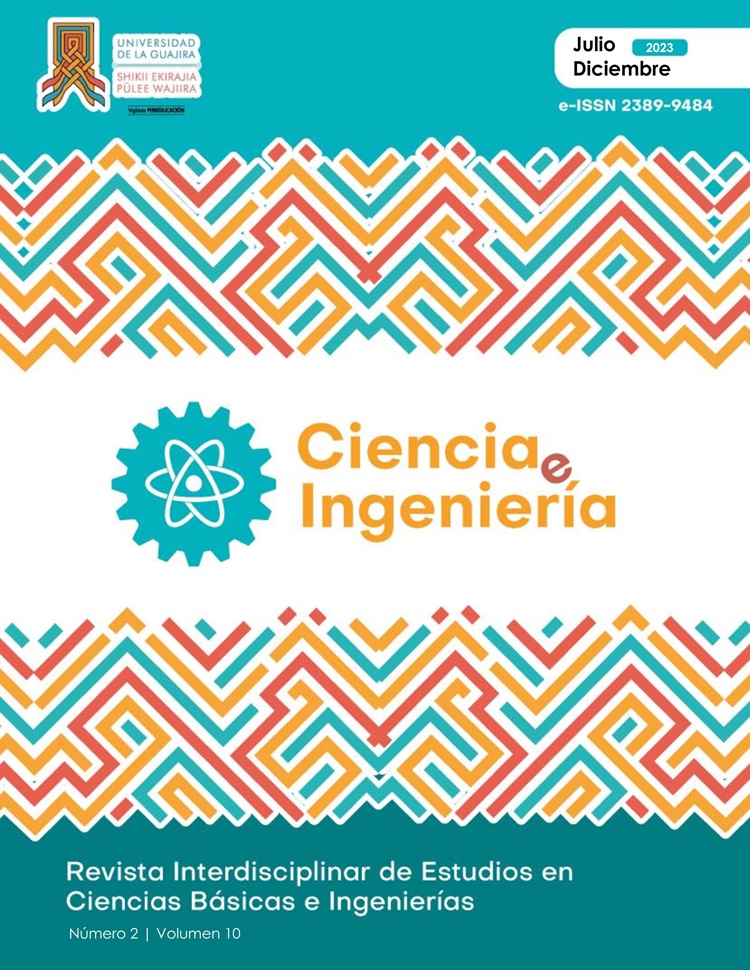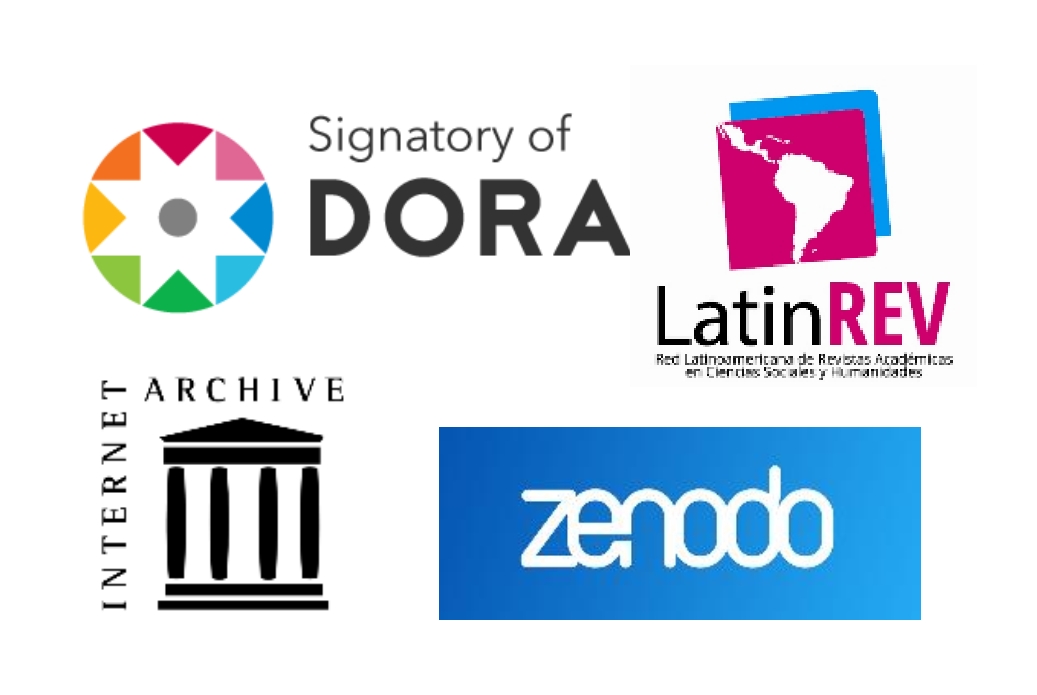Evaluating the use of RBG drone imagery to study vegetation associated with resource islands
DOI:
https://doi.org/10.5281/zenodo.10279636Keywords:
VANT, Remote sensing, Resource islands, Vegetation indices, IVT Index, Land cover fraction, VARI Index, dry forestAbstract
Resource islands (RI) are crucial vegetation arrangements in arid and semi-arid zones, and understanding their structure and dynamics is vital for comprehending their role in ecosystem services supply. Fieldwork with conventional methodologies is limited due to climatic conditions and technical difficulties. Therefore, evaluating alternative indirect methodologies based on geospatial data capture can increase information availability and facilitate study. In this study, we analyzed the dynamics of interannual structural change in IR of a semiarid zone of the La Guajira Peninsula. The methodological strategy involved GIS analysis of RGB orthophotomosaics acquired by a drone or UAV. Interannual changes associated with vegetation cover fraction were estimated using the VARI index, and chlorophyll content using the triangular greenness index in GIS. The results depict a map describing the effect of increased water availability in a year with a climatic anomaly on vegetation cover. Furthermore, the triangular greenness index allowed an inference about the role of water in nitrogen assimilation, reflecting an increase in chlorophyll production. Finally, GIS tools enable obtaining geospatial data describing the structure and some biological functions in a less time- and cost-intensive manner compared to traditional methodologies, allowing systematic monitoring of ecological assets such as vegetation in the IR.
Downloads
References
Almeida, D. R. A. D., Broadbent, E. N., Ferreira, M. P., Meli, P., Zambrano, A. M. A., Gorgens, E. B., Resende, A. F., Almeida, C. T. D., Amaral, C. H. D., Corte, A. P. D., Silva, C. A., Romanelli, J. P., Prata, G. A., Papa, D. D. A., Stark, S. C., Valbuena, R., Nelson, B. W., Guillemot, J., Féret, J-B., ... & Brancalion, P. H. S. (2021). Monitoring restored tropical forest diversity and structure through UAV-borne hyperspectral and lidar fusion. Remote Sensing of Environment, 264, [112582]. https://doi.org/10.1016/j.rse.2021.112582
Brito, A., & Cumandá, N. (2021). Herramientas SIG para el estudio de la cobertura vegetal y cambio de uso de suelo en el cantón Chunchi, provincia del Chimborazo. http://dspace.ups.edu.ec/handle/123456789/20104
Candiago, S., Remondino, F., De Giglio, M., Dubbini, M., & Gattelli, M. (2015). Evaluating Multispectral Images and Vegetation Indices for Precision Farming Applications from UAV Images. Remote Sensing, 7(4), 4026-4047. https://doi.org/10.3390/rs70404026
Castellanos, L. C. J., Buitrago, M. L. P., & Soto, L. I. C. (2022). Determinación de la diversidad taxonómica y funcional de hongos a través de metagenómica en isla de recursos y su influencia en la degradación de materia orgánica en ambiente semiárido de La Guajira. https://repositorio.unicolmayor.edu.co/handle/unicolmayor/5713
Díaz, R. A. R. (2020). Análisis espacial de coberturas vegetales presentes en comunidades indígenas ubicadas en el municipio de Uribia, departamento de La Guajira, Colombia. https://ridum.umanizales.edu.co/xmlui/handle/20.500.12746/5904
Gitelson, A. A., Stark, R., Grits, U., Rundquist, D., Kaufman, Y., & Derry, D. (2002). Vegetation and soil lines in visible spectral space: A concept and technique for remote estimation of vegetation fraction. International Journal of Remote Sensing, 23(13), 2537–2562. https://doi.org/10.1080/01431160110107806
González, A., Amarillo, G., Amarillo, M., & Sarmiento, F. (2016). Drones Aplicados a la Agricultura de Precisión. Publicaciones e Investigación, 10, 23. https://doi.org/10.22490/25394088.1585
Guerra-Martínez, F., García Romero, A., & Martínez Morales, M. A. (2020). Evaluación de la resiliencia ecológica de los bosques tropicales secos: Una aproximación multiescalar. Madera y Bosques, 26(3). https://doi.org/10.21829/myb.2020.2631983
Hunt, E. R., Doraiswamy, P. C., McMurtrey, J. E., Daughtry, C. S. T., Perry, E. M., & Akhmedov, B. (2011). A visible band index for remote sensing leaf chlorophyll content at the canopy scale. International Journal of Applied Earth Observation and Geoinformation, 21, 103-112. https://doi.org/10.1016/j.jag.2012.07.020
IDEAM - Instituto de Hidrología, Meteorología y Estudios Ambientales (IDEAM). Consulta y Descarga de Datos Hidrometeorológicos. Consultado: (28/03/2023). http://dhime.ideam.gov.co/atencionciudadano/
Karlin, M. S., Coirini, R., Ringuelet, A., Bernasconi Salazar, J., Cora, A., Contreras, A., Bravo, M. B., & Buffa, E. (2021). Evaluación biofísica de islas de fertilidad en el Chaco Árido (Argentina). AgriScientia, 38(1), 1–13. https://doi.org/10.31047/1668.298x.v38.n1.30529
Li, S., Wang, C., Yang, S., Chen, W., Li, G., Luo, W., Wei, G., & Chen, C. (2023). Determining the contribution of microbiome complexity to the soil nutrient heterogeneity of fertile islands in a desert ecosystem. Science of The Total Environment, 857, 159355. https://doi.org/10.1016/j.scitotenv.2022.159355
Manrique, E. (2003). Los pigmentos fotosintéticos, algo más que la captación de luz para la fotosíntesis. Ecosistemas, 12. Metternicht, G. (2003). Vegetation indices derived from high-resolution airborne videography for precision crop management. International Journal of Remote Sensing, 24(14), 2855–2877. https://doi.org/10.1080/01431160210163074
Moncayo-Riascos, M. C., & Gálvez-Cerón, A. (2018). Islas de fertilidad: Una revisión sistemática de su estructura y operación. Idesia (Arica), 36(1), 115-122. https://doi.org/10.4067/S0718-34292018000100115
Montaño, N. M., Ayala, F., Bullock, S. H., Briones, O., García Oliva, F., García Sánchez, R., Maya, Y., Perroni, Y., Siebe, C., Tapia Torres, Y., Troyo, E., & Yépez, E. (2016). Almacenes y flujos de carbono en ecosistemas áridos y semiáridos de México: síntesis y perspectivas. Terra Latinoamericana, 34(1), 39-59. http://www.redalyc.org/articulo.oa?id=57344471003
Muñoz Iniestra, D. J., Chávez Mosqueda, M., Godínez Álvarez, H. O., & Cuéllar Arellano, N. A. (2017). Cambios edáficos en islas de fertilidad y su importancia en el funcionamiento de un ecosistema del valle de Tehuacán Puebla, México. Revista Terra Latinoamericana, 35(2), 123. https://doi.org/10.28940/terra.v35i2.142
Naranjo, O. L. (2020). Estrategias de parametrización de vuelo de un equipo RPAS para la generación de Ortomosaicos a partir de sensores multiespectrales y RGB. https://repositorio.ucm.edu.co/handle/10839/3438
de Ocampo, A. L. P., Bandala, A. A., & Dadios, E. P. (2019). Estimation of Triangular Greenness Index for Unknown Peak Wavelength Sensitivity of CMOS-acquired Crop Images. 2019 IEEE 11th International Conference on Humanoid, Nanotechnology, Information Technology, Communication and Control, Environment, and Management (HNICEM), 1-5. https://doi.org/10.1109/HNICEM48295.2019.9072796
Pinto, J., Rueda-Chacón, H., & Arguello, H. (2019). Classification of Hass avocado (Persea americana mill) in terms of its ripening via hyperspectral images. TecnoLógicas, 22(45), 109-128. https://doi.org/10.22430/22565337.1232
Radočaj, D., Šiljeg, A., Marinović, R., & Jurišić, M. (2023). State of Major Vegetation Indices in Precision Agriculture Studies Indexed in Web of Science: A Review. Agriculture, 13(3), 707. https://doi.org/10.3390/agriculture13030707
Rimolo-Donadio, R., Arriola Valverde, S., Umaña Soto, J., López Sampson, A., Sepúlveda, N., Villalobos Avellán, L. C., Monge Mora, J. C. & Somarriba, E. (2021). Fotogrametría Digital con Sistemas Aéreos no Tripulados para el Análisis de Sistemas Agroforestales. Turrialba, C. R. CATIE, 2021. 66 p. https://repositorio.catie.ac.cr/handle/11554/343
Rosero, A. (2021). Evaluación del uso de drones como herramienta de apoyo para un efectivo control y monitoreo de páramos en Colombia. https://hdl.handle.net/10495/24678
Silva, M. F., Maciel, G. M., Gallis, R. B., Barbosa, R. L., Carneiro, V. Q., Rezende, W. S., & Siquieroli, A. C. S. (2022). High-throughput phenotyping by RGB and multispectral imaging analysis of genotypes in sweet corn. Horticultura Brasileira, 40(1), 92-98. https://doi.org/10.1590/s0102-0536-2022012
Downloads
Published
How to Cite
Issue
Section
License
Copyright (c) 2023 revadmin

This work is licensed under a Creative Commons Attribution-NonCommercial-NoDerivatives 4.0 International License.





